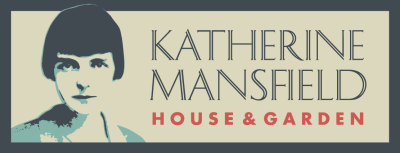TREASURE IN THE CHILDREN'S TOY BOX
- 24 August 2021
- KMHG Webmaster
During her Te Herenga Waka Victoria University of Wellington Museum and Heritage Studies placement at Katherine Mansfield House & Garden in June 2021, Ailish Wallace-Buckland took a particular interest in some of the children's toys in the Katherine Mansfield House & Garden collection and what they can tell us about the lives of colonial Victorian children. She wrote this wonderful blog post to share her research. Thank you Ailish!
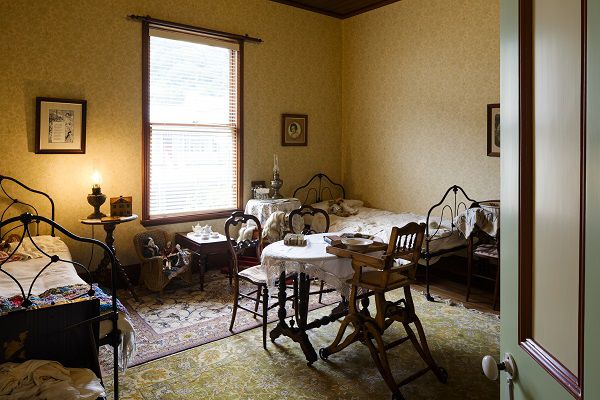
Image: The Children's Bedroom at Katherine Mansfield House & Garden in December 2019, photographed by Jason Mann Photography.
Anyone who is familiar with Katherine Mansfield’s work will know that she has a particular skill in capturing the essence of children and childhood. Whether drawing on her own experiences in Wellington – at the family’s city homes in Thorndon or in the more rural Karori – to exploring her views around having children of her own, Mansfield clearly and cleverly distils children’s play and experiences of the world around them in her writing. The realm of children’s play and imagination is perhaps best expressed by Mansfield in some of her most well-known stories – such as ‘The Doll’s House’, as well as through the role-play games of the Burnell children in ‘Prelude’. Through these stories readers are able to piece together images of a childhood that may well have reflected Mansfield’s own, and that, more generally, depicts a middle-class Pākehā colonial childhood in 19th century New Zealand. In addition to written accounts – fictionalised or not – of childhood, children’s toys and games provide a tangible way for us, in 2021, to help envision what life would have been like for a Victorian child in Wellington. Within the Katherine Mansfield House & Garden collection there are a great number of items that provide us with that tangible link into the lives of children 100 plus ago.
In the 19th century, Victorian children had far fewer toys that children do today. The kind of toys they had also reflected the social status of their families. For example, only children of the wealthy would have such toys as rocking horses, train sets, toy soldiers, and dolls' houses, whereas children from poor families were more likely to play with home-made dolls such as peg dolls, spinning tops, and skipping ropes.[1] Toys also tell us as much about parents as they do children. “Rather than representing something a child desires,” historian (and current Katherine Mansfield Birthplace Society Board Member) Lynette Townsend writes, “adult-designed toys are illustrative of items parents may feel obligated to purchase for their children not only out of necessity, but as a form of surrogate caregiving and affection.”[2] New Zealand parents in the 1800s, Townsend remarks, also considered the educational value associated with toys and play to be of great value. The educational potential of toys was something that aspirational middle-class settlers – like the Beauchamp family – were especially concerned with, seeing the education of children as an essential part of establishing a better, and more civilised, settler society.[3]
Victorian toys and play were also far more strictly gendered than they are today. Though we’ve yet to fully escape the blue/pink divisions, the gendered nature of Victorian childhood was much more clear-cut. The 19th century saw Britain, and (by proxy) its colonies, become increasingly influenced by biological notions of gender. These adult ideas were mirrored in the world of children, with differences between acceptable play for girls and boys becoming more distinct as the century progressed. Whilst dolls had previously been played with by girls and boys alike, now they were more likely to be associated with girlhood.[4] Perhaps unsurprisingly, gendered play was most clear in the restrictions and assumptions it placed upon Victorian girls. Things like miniature tea sets or dolls demonstrate the ways in which girls were expected to learn how to be a hostess, an entertainer, and to learn the ways of the domestic sphere that they were intended to rule in their adult years. Boys, however, were more likely to play with toy soldiers and marbles, and have more freedom in the outdoors.[5]

Image: The Beauchamp children c1898. Note Jeanne (seated right) is holding a doll and Leslie (standing middle left) appears to be wearing a sword belt with a small sheathed sword resting on his hip. Kathleen Mansfield Beauchamp (who would later choose to use the name Katherine Mansfield) is standing at the back left, next to her eldest sister Vera. Charlotte is seated at the front. Image courtesy of the Alexander Turnbull Library, PAColl-4488.
With this foundation, I’ll now explore some of the toys that are in the Katherine Mansfield House & Garden collection. Anyone who has visited the house is sure to remember the striking red-roofed green doll’s house, decorated to match descriptions of the house in Mansfield’s ‘The Doll’s House’, that sits in the Children’s Bedroom. The room also displays numerous dolls, games, and other toys that would have existed in the backdrop of many well-off Victorian households. The spark behind exploring the topic of Victorian toys and games for this piece was ignited by my own work updating collection records at Katherine Mansfield House & Garden. When a seemingly innocuous collections box turned into a toy-box treasure trove with sixty-plus items nestled within it, my curiosity was piqued as it contained so many different kinds of items. From ceramic farm animal ornaments to papier-mâché ducks, from doll furniture (miniature chamber pot and all) to toy soldiers, and of course to dolls of many kinds, this single box alone demonstrates the great richness and possibilities in researching and understanding Victorian children, play, and childhood that material objects present us with.
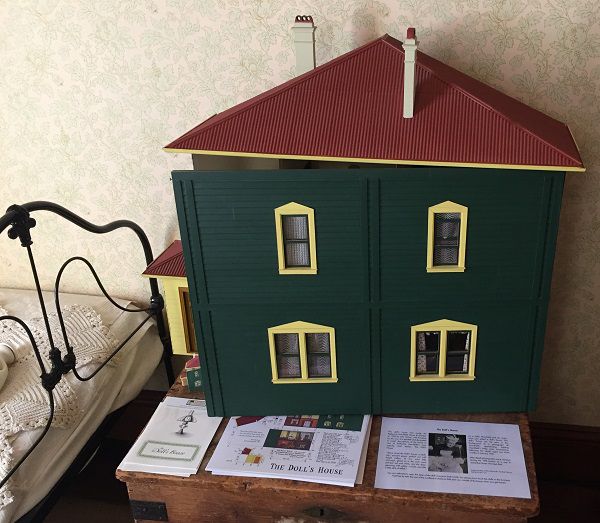
Image: The doll's house at Katherine Mansfield House & Garden. It was made especially for the collection in 1990 by John Parker. The exterior design matches the house at 25 Tinakori Road, but it is painted to match the description of the Burnell children's doll's house in Mansfield's story 'The Doll's House': "There stood the Doll's house, a dark, oily, spinach green, picked out with bright yellow. Its two solid little chimneys, glued on to the roof, were painted red and white, and the door, gleaming with yellow varnish, was like a little slab of toffee.”
Only the children of rich families, as has been mentioned, would have had dolls' houses to play with. Made by skilled craftsmen they were a firm favourite in well-to-do homes, and provided endless hours of make-believe fun for children as they played out real-life scenarios with replica miniatures of furniture, décor, and equipment that could be found in their actual life-size homes.[6] As a child, Katherine Mansfield and her sisters were gifted a doll’s house, much as the Burnell family are in the aptly-named story. The Beauchamp girls’ doll’s house can actually be seen in the background of a photograph of Mansfield’s grandmother holding Mansfield’s baby sister Gwendoline (who died aged just three months).
In addition to their capacity to be educational models, prompting girls to become good housewives, Nancy Wei-Ning Chen argues that dolls' houses and their miniature scale also provided a means and space for young girls to express their imagination, creativity and agency.[7] She proposes that doll's house play makes players aware of a number of concepts including, “measurement, size, scale, proportionality, and the ways things relate to their surroundings.”[8] Lessons that were perhaps understood even clearer when girls from middle-class families made their own doll’s houses and kitted them out with furniture and dolls they made by hand.[9] Some of our current fascination and interest in doll's house play perhaps comes from that notion associated with the size difference that enabled young girls to take full control over their miniature households. As Wei-Ning Chen points out, though this toy was particularly gendered, there too existed the space for young girls to broaden their minds and ways of thinking and creativity within those (literal) restricted realms.
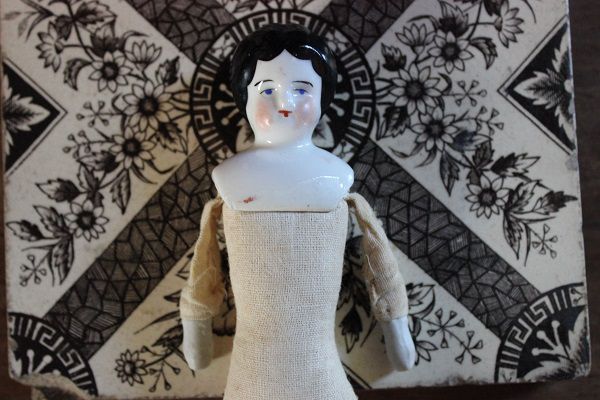
Image: A cloth-body doll with a ceramic head and shoulders in the Katherine Mansfield House & Garden collection.
One cannot mention dolls' houses without exploring dolls themselves. The Katherine Mansfield House & Garden collection includes a variety of different kinds of dolls, including porcelain dolls, dolls with moveable parts, cloth dolls and ‘Frozen Charlotte’ dolls. Whilst some may find them a bit spooky, dolls were much beloved toys for many children in colonial New Zealand. A great deal of New Zealand’s dolls came from Germany in this period, as during the later 19th century it was the centre of the world’s toy industry.[10] Initially these dolls were made up of wood or metal parts, but later bisque (a ceramic material) was used – fired and then painted, bisque gave a “remarkable life-like appearance to the ‘skin’ of the doll.”[11] It has been noted by many scholars on this topic that dolls were used by 19th century families as “vehicles in feminine socialisation” – that is, they were also used to help teach young girls how to become good wives and mothers. Dolls could be used to help girls learn “wifely skills” such as sewing, by making doll’s clothes; etiquette, by holding tea parties; and childcare, through playing with baby dolls.[12]

Image: A peg doll (with its collection tag) in the Katherine Mansfield House & Garden collection. This doll belonged to Mansfield's sister, Jeanne, and was gifted by Jeanne's daughter in 2012.
The Katherine Mansfield House & Garden collection also contains toys of the more ‘exotic’ type. For example, there are a series of ceramic ornaments in the shape of zoo animals (with a few dogs too). An elephant, camel, lion, tiger, bear, and monkey make up part of this set. The collection also holds a rather time-worn monkey toy, who is dressed in a shirt and trousers and has moveable limbs.
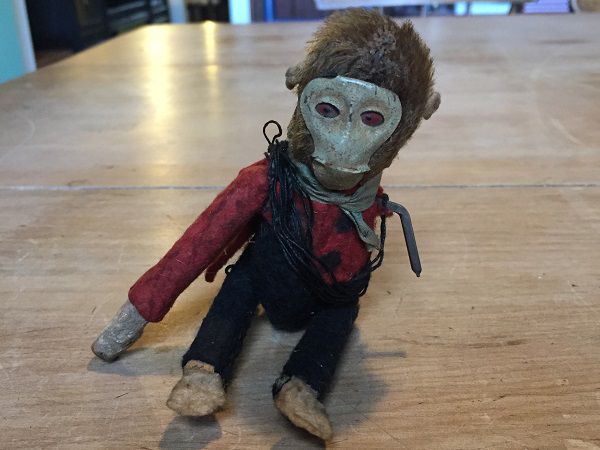
Image: A toy monkey from the Katherine Mansfield House & Garden collection.
Though Wellington Zoo’s famous elephant Kamala didn’t arrive in the city until 1953, an interest in tropical animals had a long history in Britain and the colonial imagination – an interest that no doubt also captured the imagination of children in Victorian New Zealand. From the time of the 13th century menagerie in London – which saw the Tower of London host zebras, tigers, polar bears, owls, and elephants too – the appeal of exotic animals has persisted over the centuries.[13] This appeal, arguably, crossed over with the 19th century British interest in the Eastern world (which is also known as British Orientalism), with unfamiliar and unusual animals adding to this attraction. Orientalism, or Japonisme, also existed in colonial New Zealand, with settler families using Japanese-style goods, clothing, and furniture to demonstrate their wealth and worldly sophistication. The original bamboo-shaped staircase balusters in the Katherine Mansfield House & Garden are an example of this. Whilst the children’s exotic animal toys express the Victorian Eastern fascination on a small scale, they nonetheless reveal another way in which adult ideas and interests were reflected in the lives – and toys – of colonial New Zealand children.
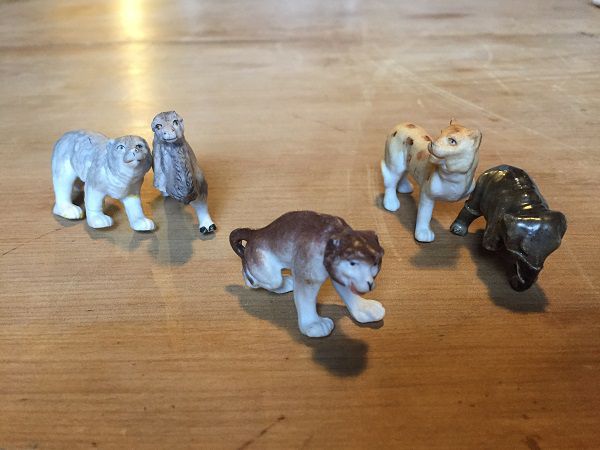
Image: Ceramic animals from the Katherine Mansfield House & Garden collection.
Though there is much more to explore in the different kinds of Victorian toys and games displayed and held at the Katherine Mansfield House & Garden, this short piece has hopefully been enlightening into the ways in which these collection items can tell us about the lives of children in 19th century New Zealand. Whilst most written records of childhood reflect an adult’s point of view “filtered through selective memory and nostalgia” – much in the way that Mansfield's stories do – tangible material goods such as toys and games can also help provide the children of the past a voice, one that is often sparse in the historic record. A voice, and representation of life, that is potentially best seen in the much-used and broken furniture of a doll’s house, in the face of a paint worn toy-soldier or fur-worn teddy, or in the repaired parts of a much loved doll. One must wonder what people will say in 100 years’ time about the remnants of childhood we’re currently leaving behind.
References
[1] ‘Hands on History: The Victorians - Victorian Toys and Games’, BBC Hands On History.
[2] Townsend, Lynette, ‘Making Paper Models in 1860s New Zealand: An Exploration of Colonial Culture through Child-Made Objects’, pp.235-254, in (Ed.) Brandow-Faller, Megan, Childhood by Design: Toys and the Material Culture of Childhood, 1700-Present (New York: Bloomsbury Publishing, 2018), p.248.
[3] Ibid. p.244.
[4] Ganaway, Bryan, ‘The Unexpected Victory of Character-Puppen: Dolls, Aesthetics, and Gender in Imperial Germany’, pp.133-152 , in (Ed.) Brandow-Faller, Megan, Childhood by Design: Toys and the Material Culture of Childhood, 1700-Present (New York: Bloomsbury Publishing, 2018), p.136.
[5] Garland, Jessie, in, Baird, Rosemary (Host.), ‘Children’s artefacts from Christchurch’, Aotearoa Unearthed, No.7, Heritage New Zealand Pouhere Taonga.
[6] 'Victorian Toys', About Britain.
[7] Wei-Ning Chen, Nancy, ‘Playing with Size and Reality: The Fascination of a Doll’s House World’, Children’s Literature in Education, 2015, Vol.46, p.278.
[8] Ibid. p.284.
[9] Ibid. p.281.
[10] Veart, David, Hello Girls & Boys: A New Zealand Toy Story (Auckland: Auckland University Press, 2015), p.48.
[11] Ibid. p.48.
[12] Baxter, Jane, in David Veart, David Veart, Hello Girls & Boys: A New Zealand Toy Story (Auckland: Auckland University Press, 2015), p.51.
[13] Bellotti, Alex, ‘Lions and Monkeys and Bears Used to Live in the Tower of London’, Londonist.
